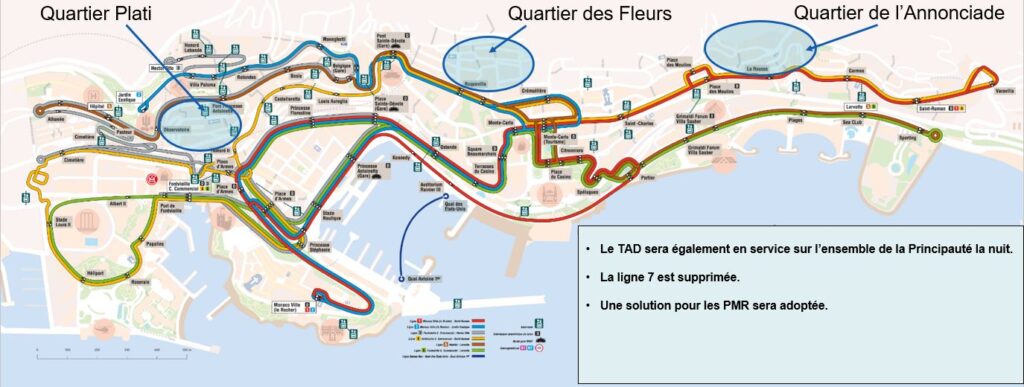Trains, buses, car parks, on-demand transport… Monaco’s major mobility projects

The Ministry of State was the venue for the presentation of the Mobility Plan in and around Monaco on Friday 9 February.
“The plan constitutes a cohesive set of operations and proposals that are feasible, financeable and effective.” Before handing over to Céline Caron-Dagioni, Pierre Dartout pointed out that the plan, for 2024 and beyond “sets out ambitions, not dreams.” “We are going to present the results of a lengthy but efficient project that has taken over 2 years, given that we couldn’t do it alone,” began the Minister of State, illustrating the headache that the issue of mobility in the Principality has been and continues to be, and the agreements that needed to be reached with France to find a certain number of solutions.
The ‘TER’, essential for workers
While the roads leading into Monaco feel more congested than ever, the figures show a slight decrease in the number of people entering and leaving the country every day. In 2023, the annual average was 98,392 entries and exits, compared with 107,738 9 years earlier, in 2015. “This may seem counter-intuitive. What explains this impression of gridlock is, in particular, the fact that the approach to the town has shifted to the west side of the Principality. The downhill tunnel (Tunnel Albert II, Ed.) has found its customer base’,” says Céline Caron-Dagioni, Ministry of Public Works, the Environment and Urban Development.
As the “only real solution” to the massive congestion on the roads leading into Monaco, the Regional Express Train (TER) is a key concern for the Monegasque Government. The Principality is a major SNCF customer, as is the Monegasque station, which reached peak passenger numbers in 2023 (7,800,000 passengers compared with 7,500,000 in 2019). “It’s efficient, low-carbon, and attracts a large number of passengers,” adds the Minister, speaking of the TER, “the key to managing cross-border traffic.”

Monaco continues to invest in rail traffic
After a low point – during which Monaco “stopped paying” because the service provided by the SNCF was not commensurate with the investment – and a reprimand from the Monegasque executive, discussions are well underway with the Government’s three contacts: SNCF Voyageurs, SNCF Gare & Connexions and SNCF Réseaux. For the 2024 budget, the priority will be investment in the ERTMS (European Rail Traffic Management System). “It’s essential, it’s the system that will enable us to increase train frequency.” The Minister referred in particular to the issue of duplex trains, which could be resolved with the ERTMS. “They don’t arrive at the station at the right time, so they leave empty. 10 minutes later, the platform is packed with commuters.”
At the request of SNCF Réseaux, Monaco is investing €11 million in this electronic system. And in return, a request from the Principality was that maintenance for Monegasque trains should be carried out in Nice and not Marseille, as is currently the case.
The timings also coincide with the change of rail operator that the Southern Region opted for in 2021, following the launch of a call for tenders. It is the first region where SNCF no longer has a monopoly. “The President of Région Sud will be coming to meet us so that we can share our objectives and ensure that the transition to this new operator is as efficient as possible,” the Minister concluded. The handover between SNCF and Transdev, the new operator, will take place next year. A more frequent, more punctual service is promised.
The new Les Salines car park
Another solution mentioned by Céline Caron-Dagioni was “the management of our peripheral car parks.” With just over 1,820 spaces, the Les Salines car park will soon be completed, near the Jardin Exotique, before the Monaco Grand Prix. The Minister said the aim will be “mixed use.” Tourists, workers from Monaco itself and beyond, and local season ticket holders who do not have private car parks, will be able to park there. “We are working on pricing that would work as an incentive to encourage some workers to relocate there rather than clogging up city centre car parks.”

And to facilitate access to the centre of Monaco for future occupants of the car park, it will have a bus station served by two new Express bus routes. These buses, run by the Compagnie des Autobus de Monaco (CAM), will only stop at two or three points on the route, to enable workers to get to their place of work quickly. And as an incentive, the Minister is talking about a future “package” whereby a car park season ticket will entitle holders to a dozen bus tickets. An underground pedestrian link will complete access to the car park, providing a direct link to the Fontvieille district.
- X1: Jardin Exotique to Place d’Armes.
- X2: from Jardin Exotique to Monte-Carlo.


The government also intends to create a La Brasca car park a few hundred metres away as the crow flies. Unlike the car park at the town limits, this one would be called a “deterrent car park.” Céline Caron-Dagioni explains: “We are aware, as are users, that traffic jams occur upstream of the Principality, particularly at the motorway exit. We want to try to reduce this problem by building a very large car park and providing an underground link to the Principality.” A long-term park-and-ride project requiring several agreements with France, as the La Brasca site is located in Eze. As for the underground link, the mode of transport has not yet been decided, but it cover 2 kilometres, arriving directly in Fontvieille district. “The studies have begun on our side, we must comply with French regulations in the matter,” concluded the Minister.

To complement the Monegasque Government’s objective of keeping part of the car traffic out of the Principality, Monaco has already committed to acquire, at least, 90 housing units and 130 parking spaces in the future development in the Carnolès district. Roquebrune Cap Martin is building more than 400 homes and 844 parking spaces in the “Coeur de Carnolès” ZAC (business estate), a project supported by the French Riviera Community (CARF). Part of it would on theory be allocated to employees working in the Principality, as it is only a few minutes walk from Carnolès station.

The Cap d’Ail underpass and the Saint-Roman interchange
While the new “Monaco Est” motorway slip road has been in service since 10 January 2024, the Government wishes to begin “an observation phase” to study the effectiveness of this new access to the Principality. And on the same subject, two further projects are on the Minister’s desk at present. First the Cap d’Ail underpass, with preparatory work due to begin at the end of the year, led by the Métropole Nice Côte d’Azur. The Principality, believes this 2-lane underpass “is important to ease traffic in the Rainier III tunnel,” which is often closed, forcing road users back into the centre of Monaco to take other exits. “This would avoid queues in the tunnel in the upward direction, which wouldn’t be possible without the underpass,” said Céline Caron-Dagioni, pointing out that the Principality is financing the project to the tune of 80%.
As the work being carried out in Roquebrune Cap-Martin – to modernise the water infrastructure on avenue Jean Jaurès and then avenue Louis Laurens – should be completed by April, according to the CARF, Monaco will be able to turn its attention to the Saint-Roman interchange, “what we call a modal node” said the Minister of Public Works, the Environment and Town Planning. “It is time we thought about how to make this roundabout more efficient, because we see that queues can form here.” A completely different traffic flow is said to be envisaged for this other gateway to the Principality, which is also regularly congested.

How to improve traffic flow in the Principality?
The last major aspect of the mobility plan envisaged by the Government is traffic within Monaco itself “a major mobility challenge.” “I get a lot of feedback from residents and employees. There are issues and we need to address them,” began the Minister. Travelling on public transport rather than by car is the main thrust of this part of the Plan, with new developments expected from 2024 onwards.
This year, several new bus routes will be put into service. They are not called Express routes, but are still faster than the CAM’s traditional routes. The 6D, for example, will start at the Albert II stop, at the Fontvieille shopping centre, and will only make two or three stops between there and the Larvotto. “We realise that there are specific spots, such as the Casino, where the bus often gets stuck,” says Céline Caron-Dagioni, adding, “if it takes an hour to cross the Principality, it is off-putting (…) We want to test these direct routes and see if they work well, if they are popular with the public.” The CAM is already recruiting drivers for the new routes, which should run from Monday to Friday, from 7 am to 7 pm, “by the end of the first quarter,” the Minister hopes.
‘Transport on demand’ being trialled
Starting in the spring, a new service will be available to CAM users. It’s a first – 7/7, day and night “Transport on demand” in Monaco, with an identical ticket system to the conventional bus routes. “We can afford to do it in the Principality and especially in the isolated neighbourhoods,” explained Céline Caron-Dagioni. In the Government’s sights, the Plati, Fleurs and Annonciade neighbourhoods, none of which are served by Monegasque buses at present.

Users will be able to order transport on demand via an app, whose provider has already been chosen by the Government. “It will pick you up at a given, quite central point in your neighbourhood, and take you along dedicated routes through the town centre.” The Minister made it clear that the idea is not “to compete with taxis,” which is why the pick-up and drop-off points will be limited. Electric 8-seater mini-buses will complement existing bus routes and will be able to pick up several users, but only from the specific bus stops in the different neighbourhoods. In the long term, this system is also intended to replace the night bus service.
In addition to these innovations, the Government wishes to continue to encourage motorists to park in car parks at the edge of town. We mentioned the subscription «package» at Les Salines car park, and a discount policy, of up to 50% on a subscription, will be introduced in similar car parks.
Greening the town through «soft mobility»
“Soft mobility” was also highlighted, inlcuding Monabike in particular. The Minister noted “remarkable usage levels” of the self-service bicycle system, which logged more than 600,000 trips in 2023, up 23% compared to 2022. 9 additional stations will be built this year, and nearly 200 additional bikes put into service. While the use of bicycles is encouraged by the Government, pedestrians are far from forgotten. As an example, the ‘Greening the town’ policy, the first phase of which will “reconnect” the La Condamine and Jardin Exotique districts. This will take the form of aerial walkways and completely landscaped sections, from the highest point in Monaco to the lowest.











